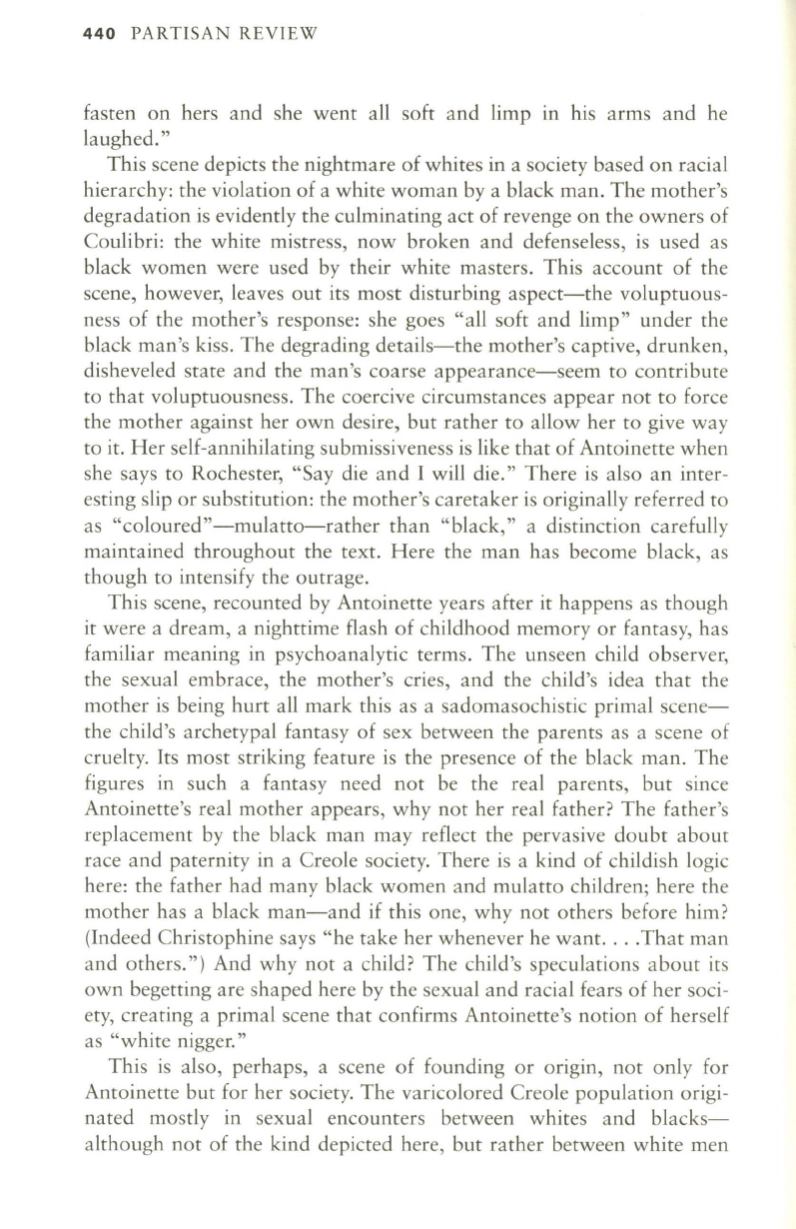
440
PARTISAN REVIEW
fasten on hers and she went all soft and limp in his arms and he
laughed."
This scene depicts the nightmare of whites in a society based on racial
hierarchy: the violation of a white woman by a black man. The mother's
degradation is evidently the culminating act of revenge on the owners of
Coulibri: the white mistress, now broken and defenseless, is used as
black women were used by their white masters. This account of the
scene, however, leaves out its most disturbing aspect-the voluptuous–
ness of the mother's response: she goes "all soft and limp" under the
black man's kiss. The degrading details-the mother's captive, drunken,
disheveled state and the man's coarse appearance-seem to contribute
to that voluptuousness. The coercive circumstances appear not to force
the mother against her own desire, but rather to allow her to give way
to it. Her self-annihilating submissiveness is like that of Antoinette when
she says to Rochester, "Say die and I will die." There is also an inter–
esting slip or substitution: the mother's caretaker is originally referred to
as "coloured"-mulatto-rather than "black," a distinction carefully
maintained throughout the text. Here the man has become black, as
though to intensify the outrage.
This scene, recounted by Antoinette years after it happens as though
it were a dream, a nighttime flash of childhood memory or fantasy, has
familiar meaning in psychoanalytic terms. The unseen child observer,
the sexual embrace, the mother's cries, and the child's idea that the
mother is being hurt all mark this as a sadomasochistic primal scene–
the child's archetypal fantasy of sex between the parents as a scene of
cruelty. Its most striking feature is the presence of the black man. The
figures in such a fantasy need not be the real parents, but since
Antoinette's real mother appears, why not her real father? The father's
replacement by the black man may reflect the pervasive doubt about
race and paternity in a Creole society. There is a kind of childish logic
here: the father had many black women and mulatto children; here the
mother has a black man-and if this one, why not others before him?
(Indeed Christophine says "he take her whenever he want....That man
and others.") And why not a child? The child's speculations about its
own begetting are shaped here by the sexual and racial fears of her soci–
ety, creating a primal scene that confirms Antoinette's notion of herself
as "white nigger."
This is also, perhaps, a scene of founding or origin, not only for
Antoinette but for her society. The varicolored Creole population origi–
nated mostly in sexual encounters between whites and blacks–
although not of the kind depicted here, but rather between white men


